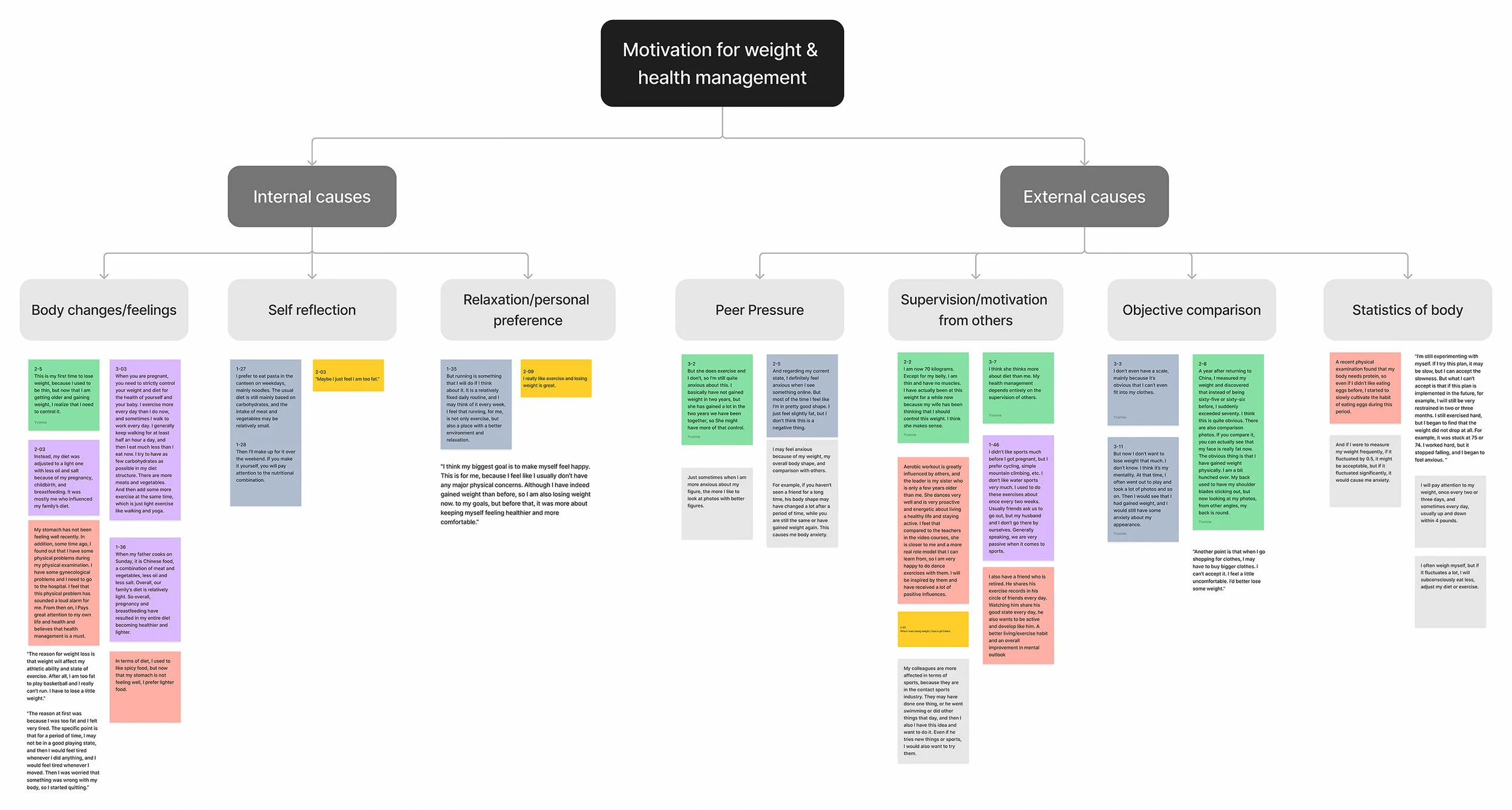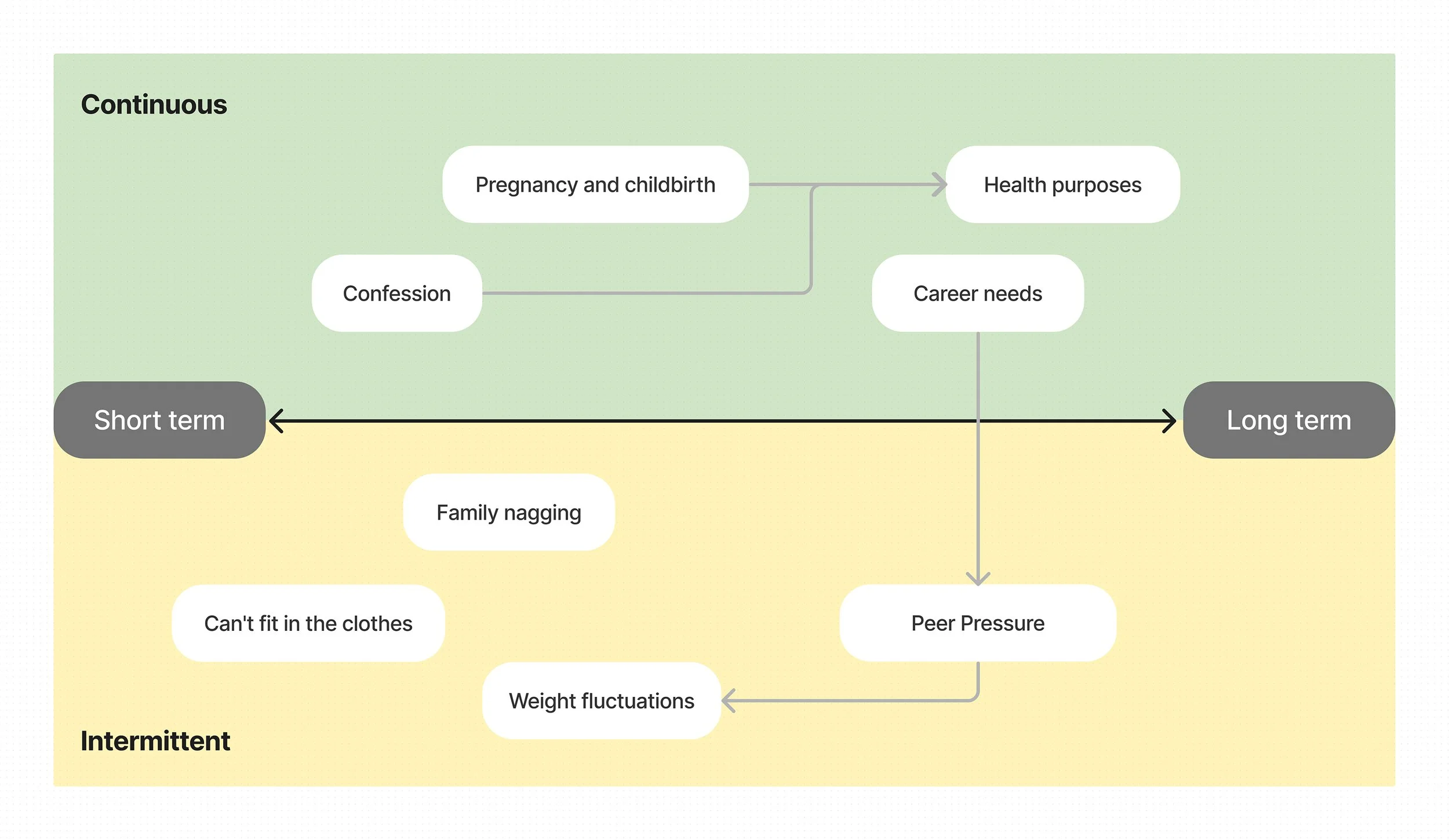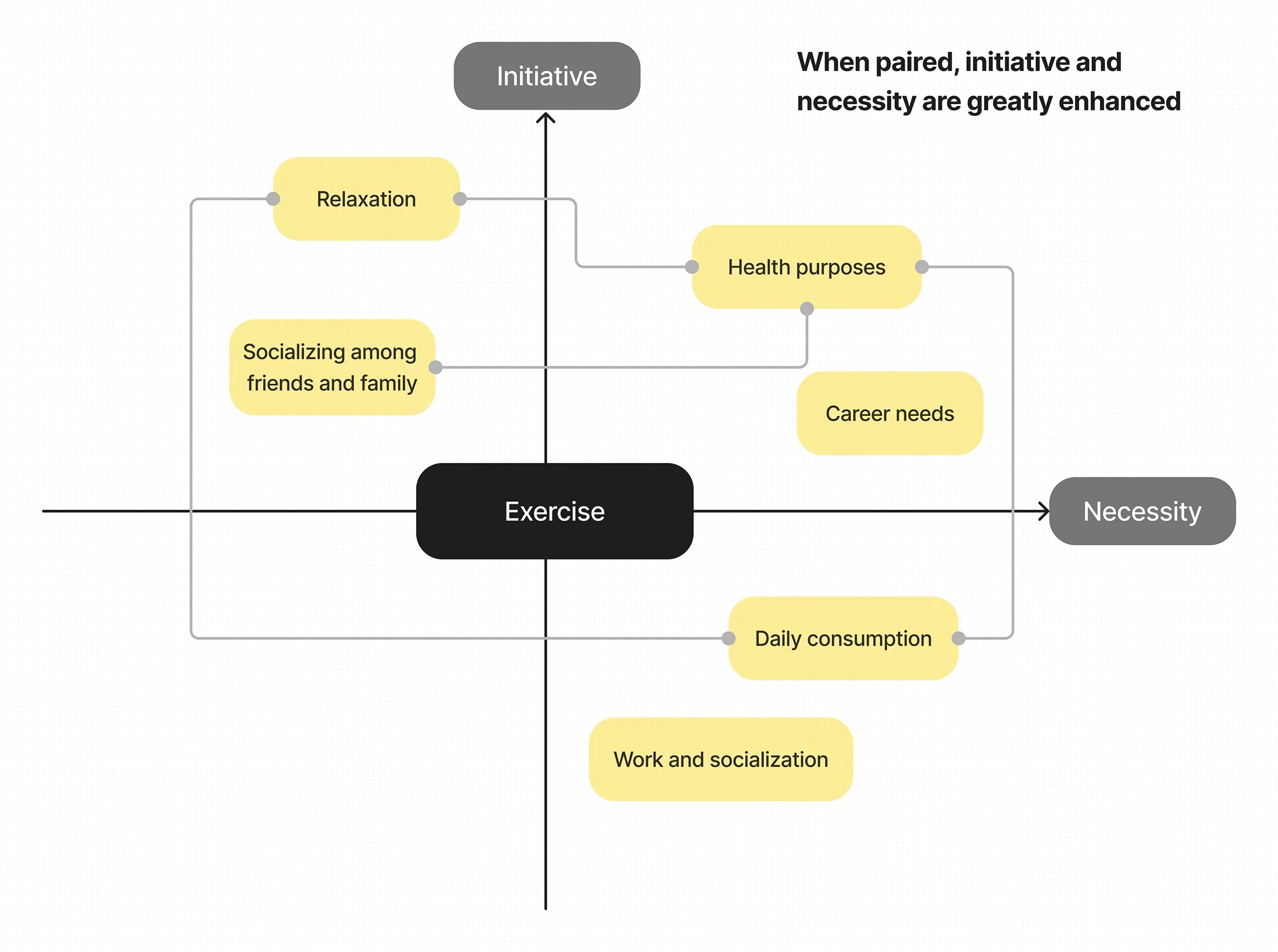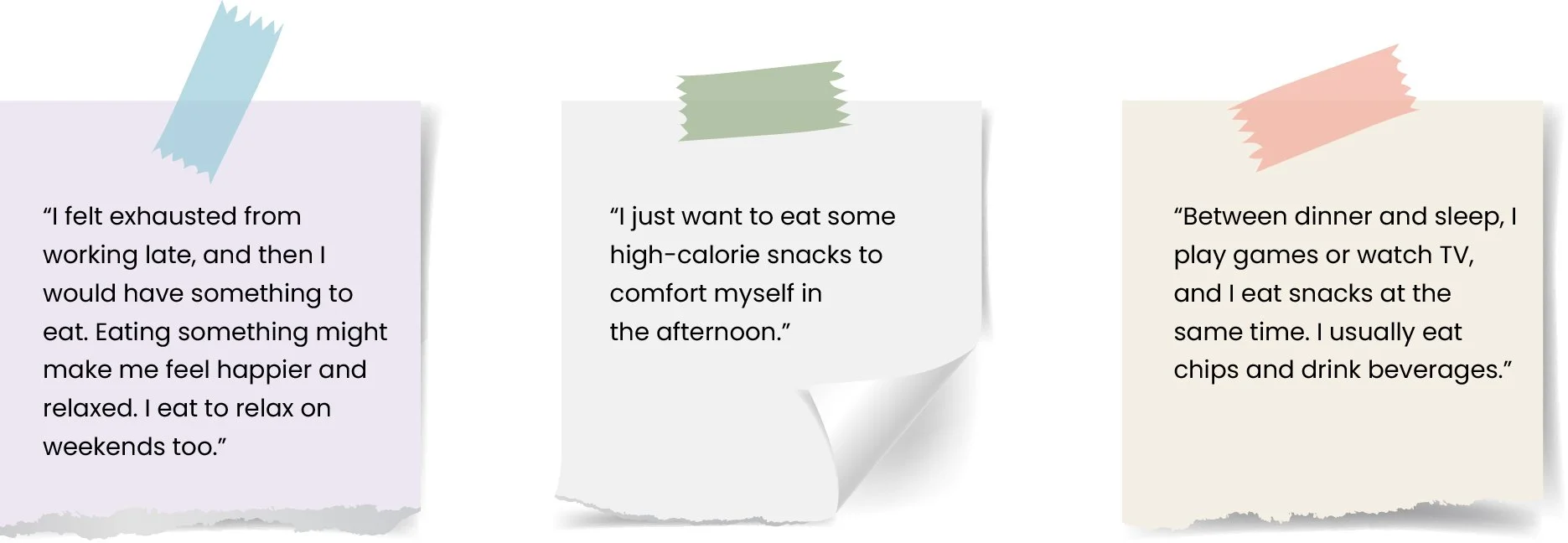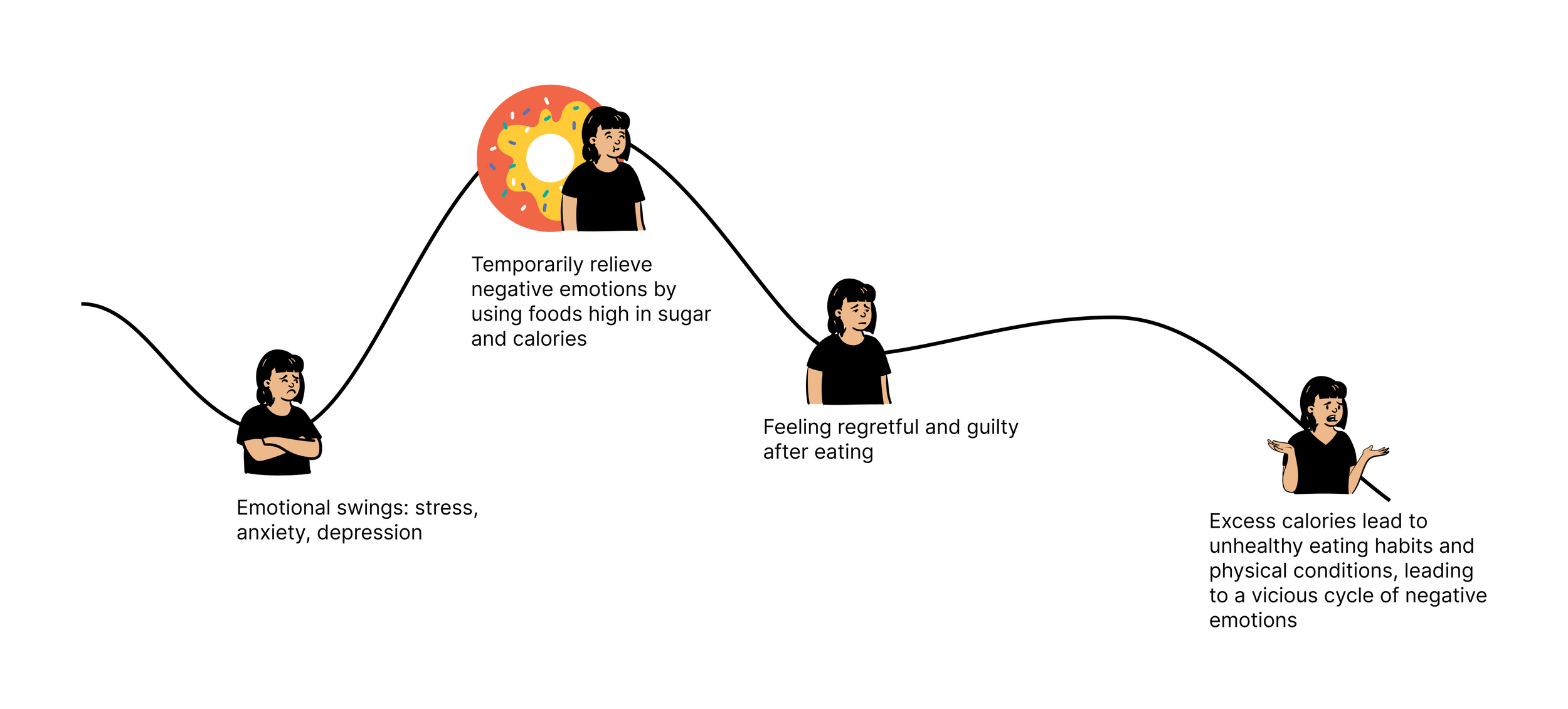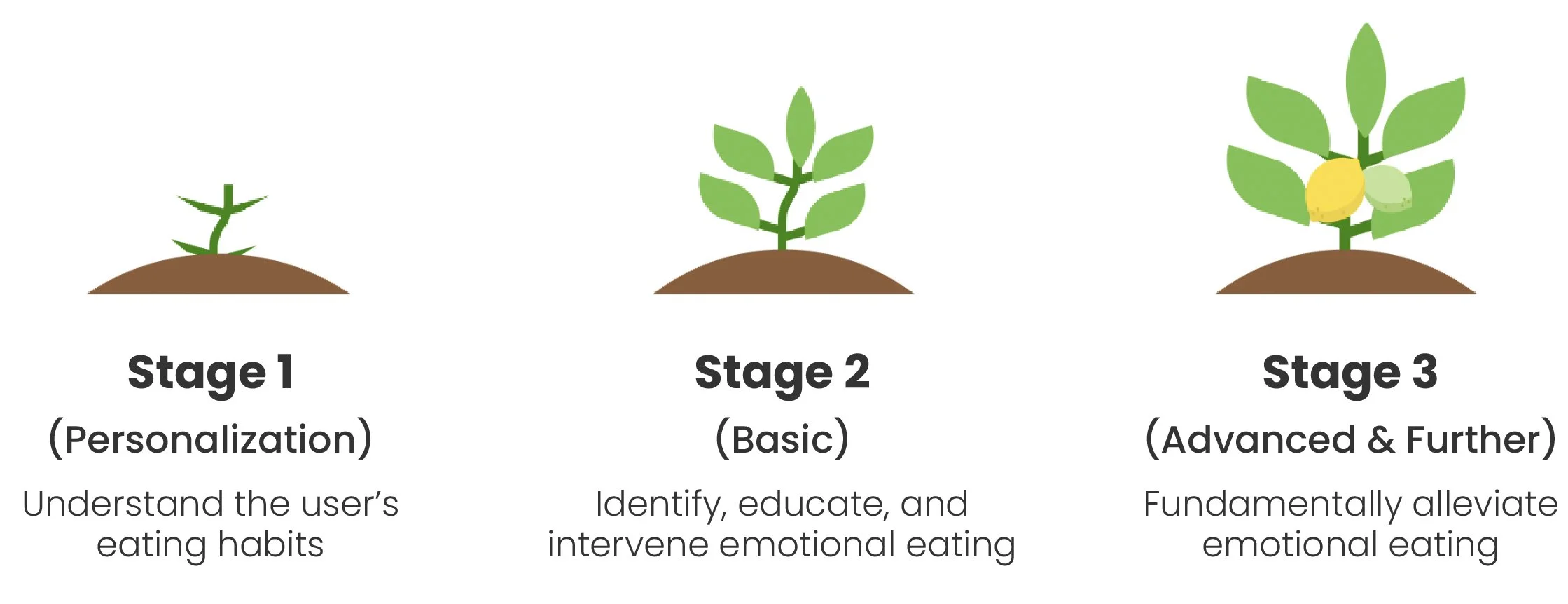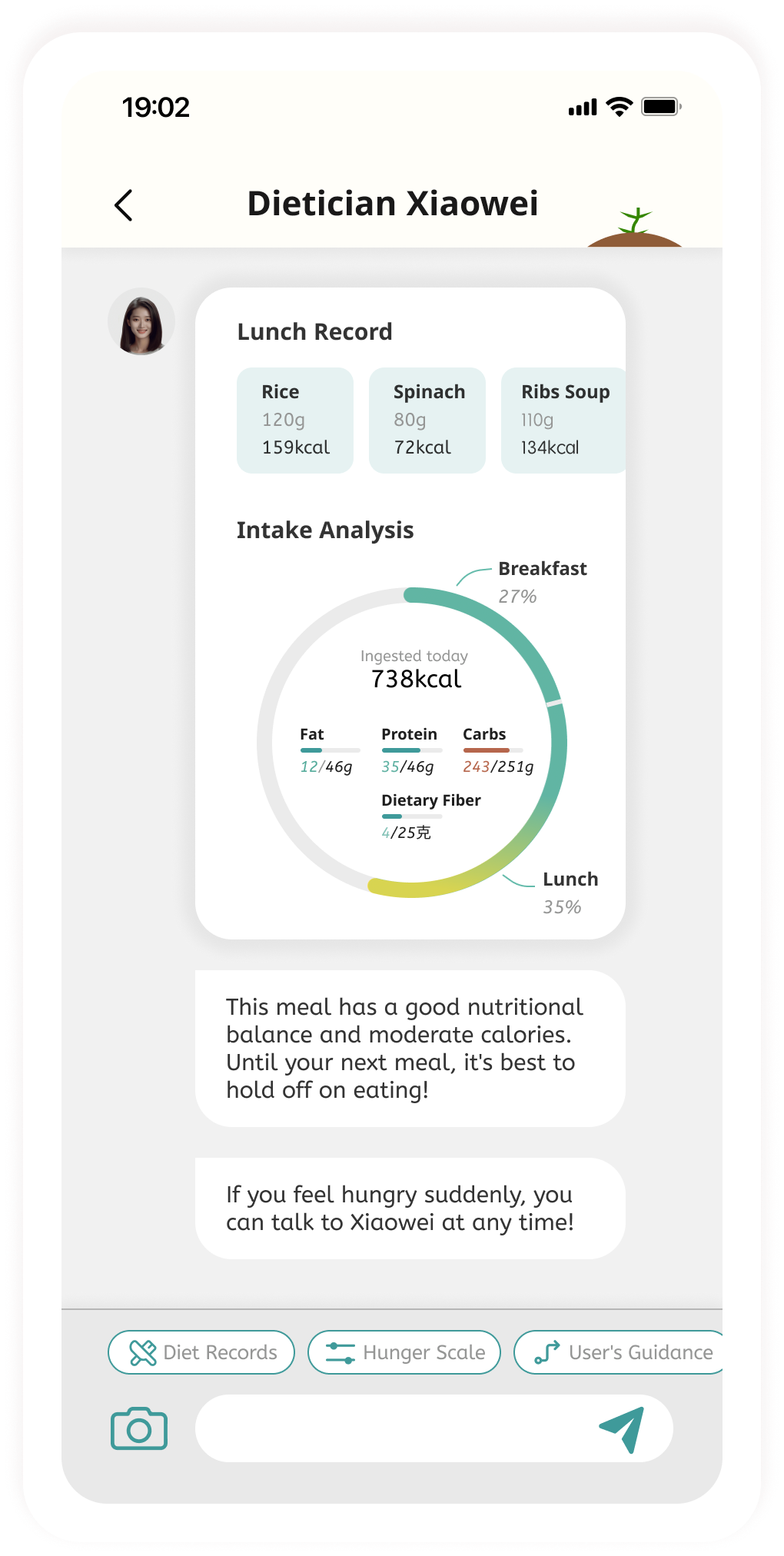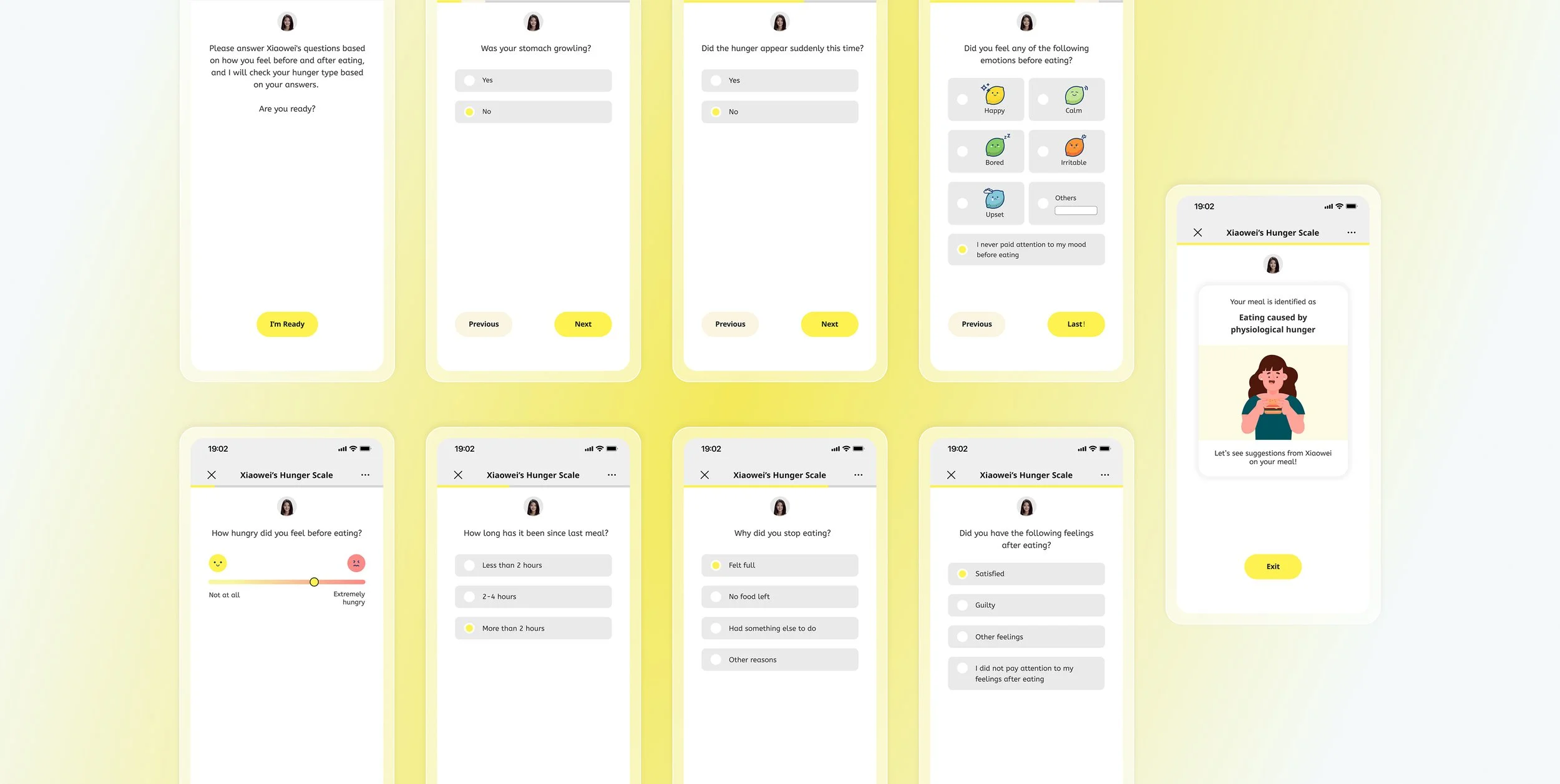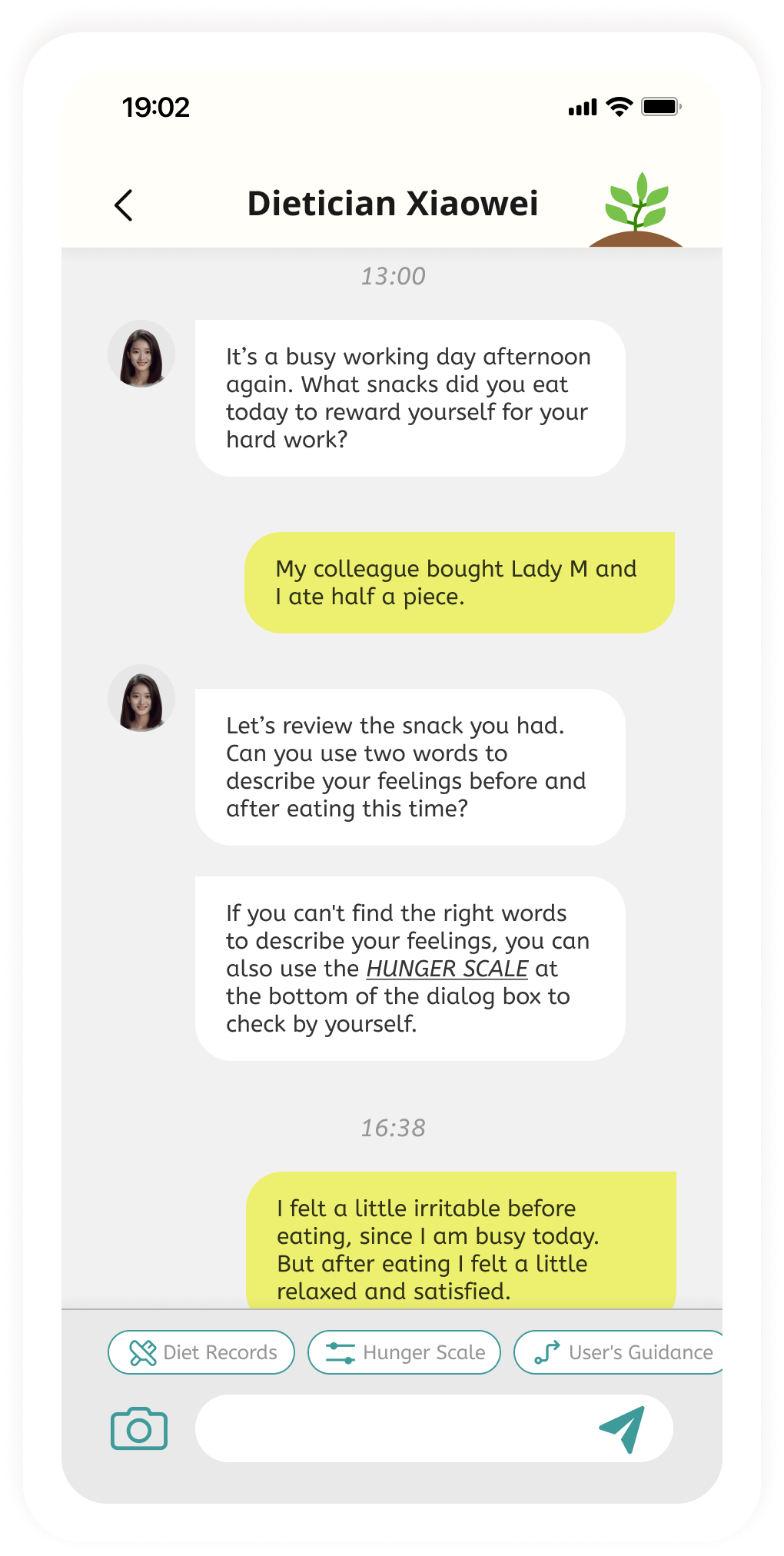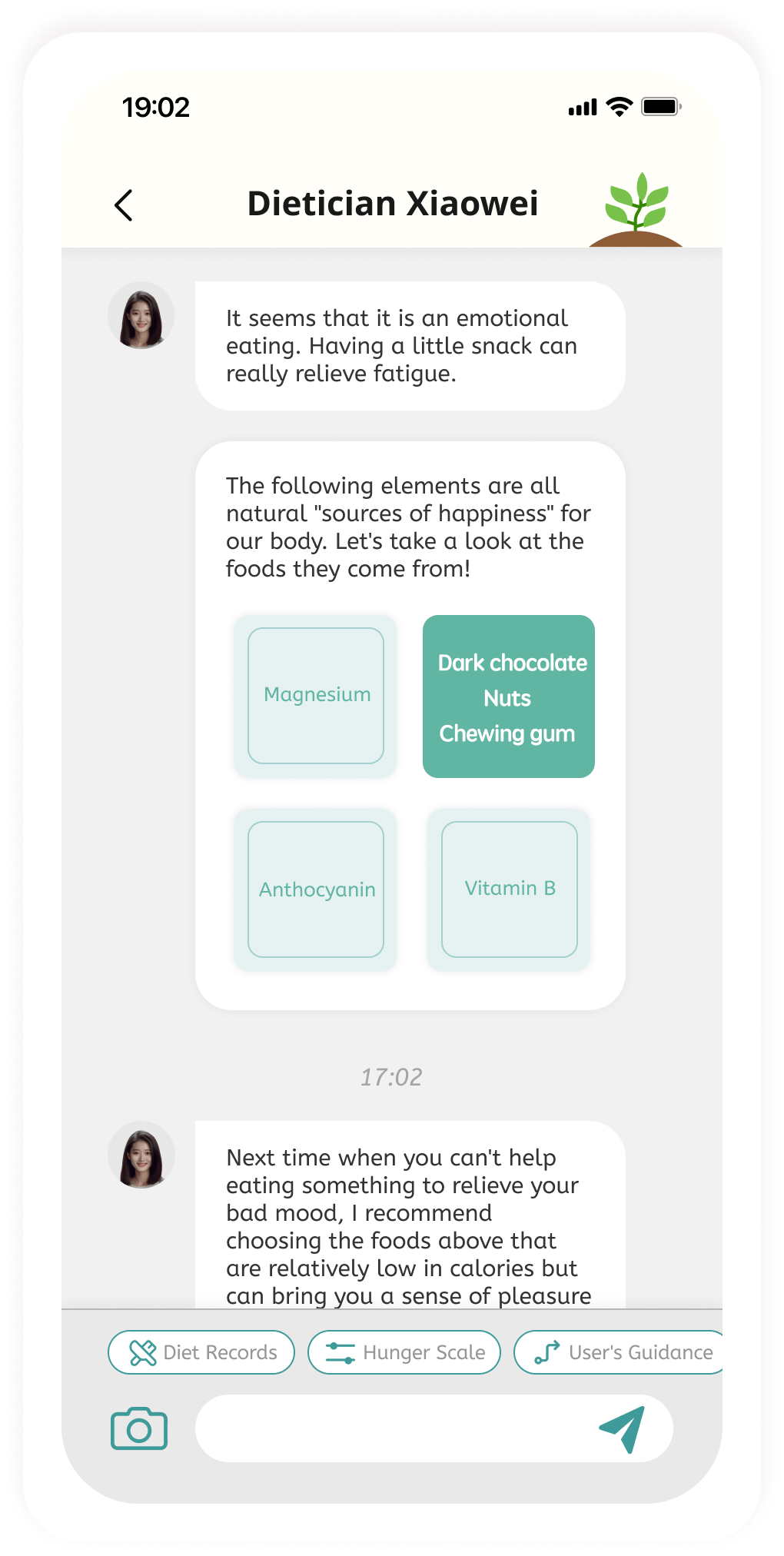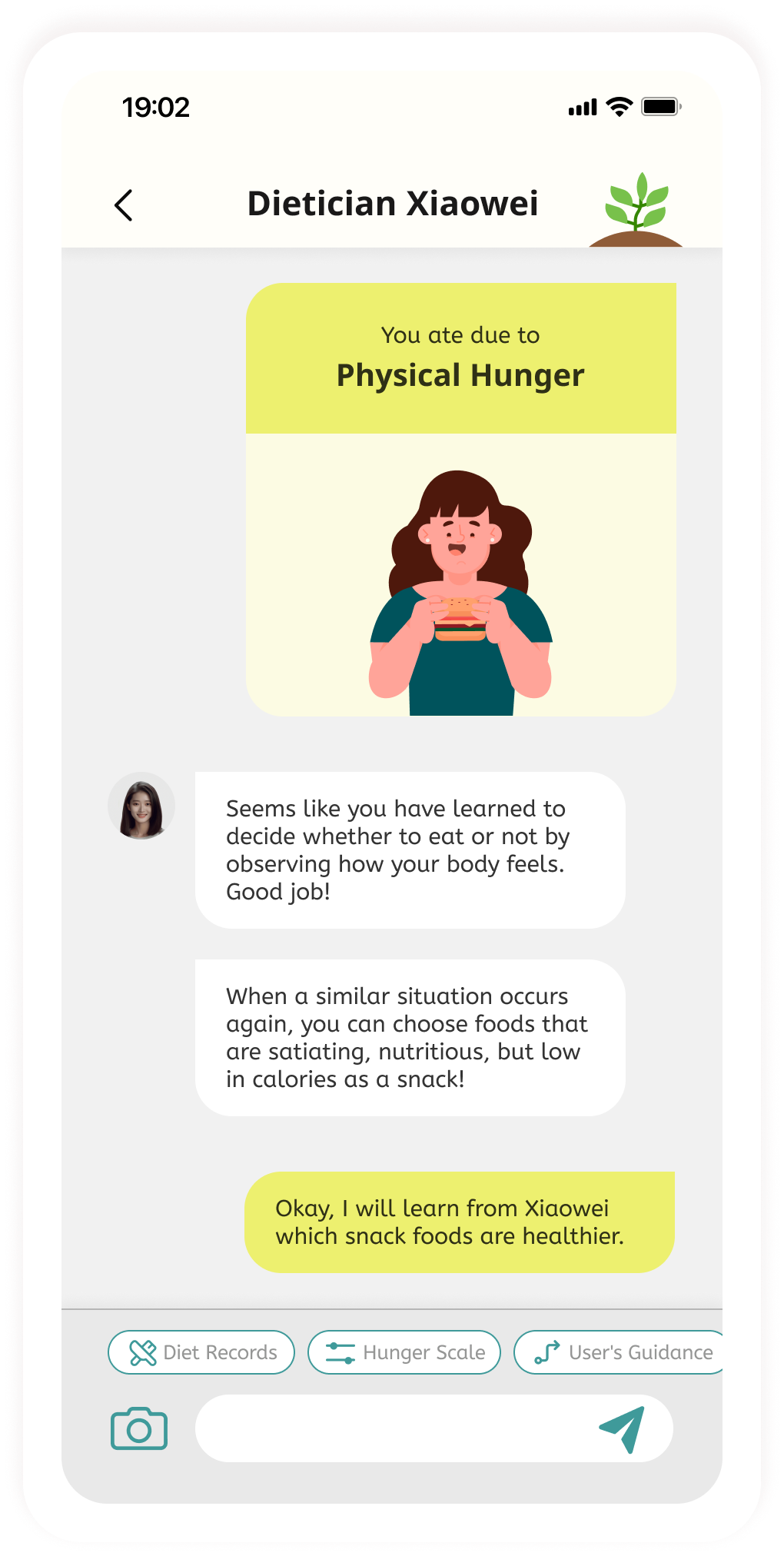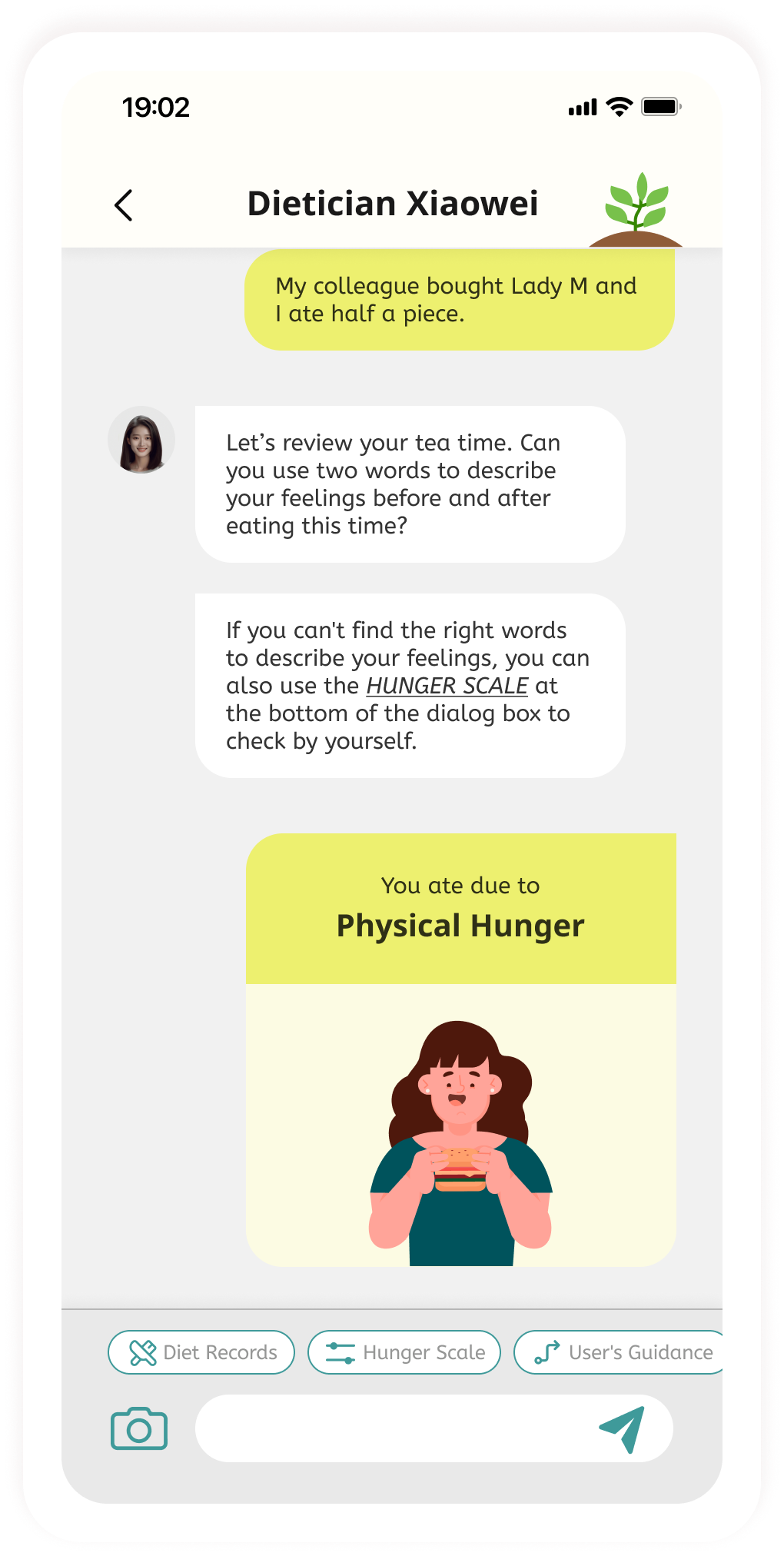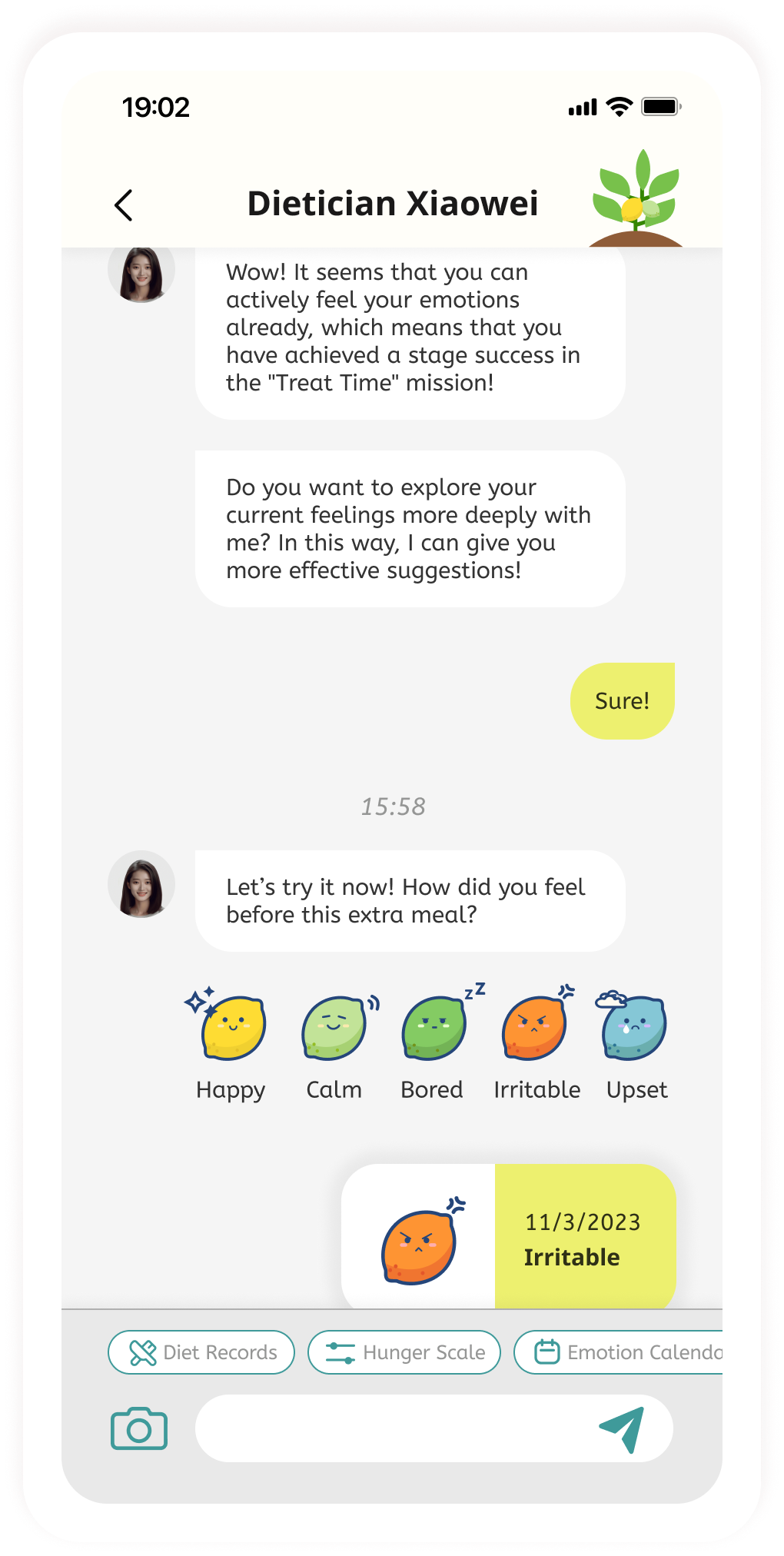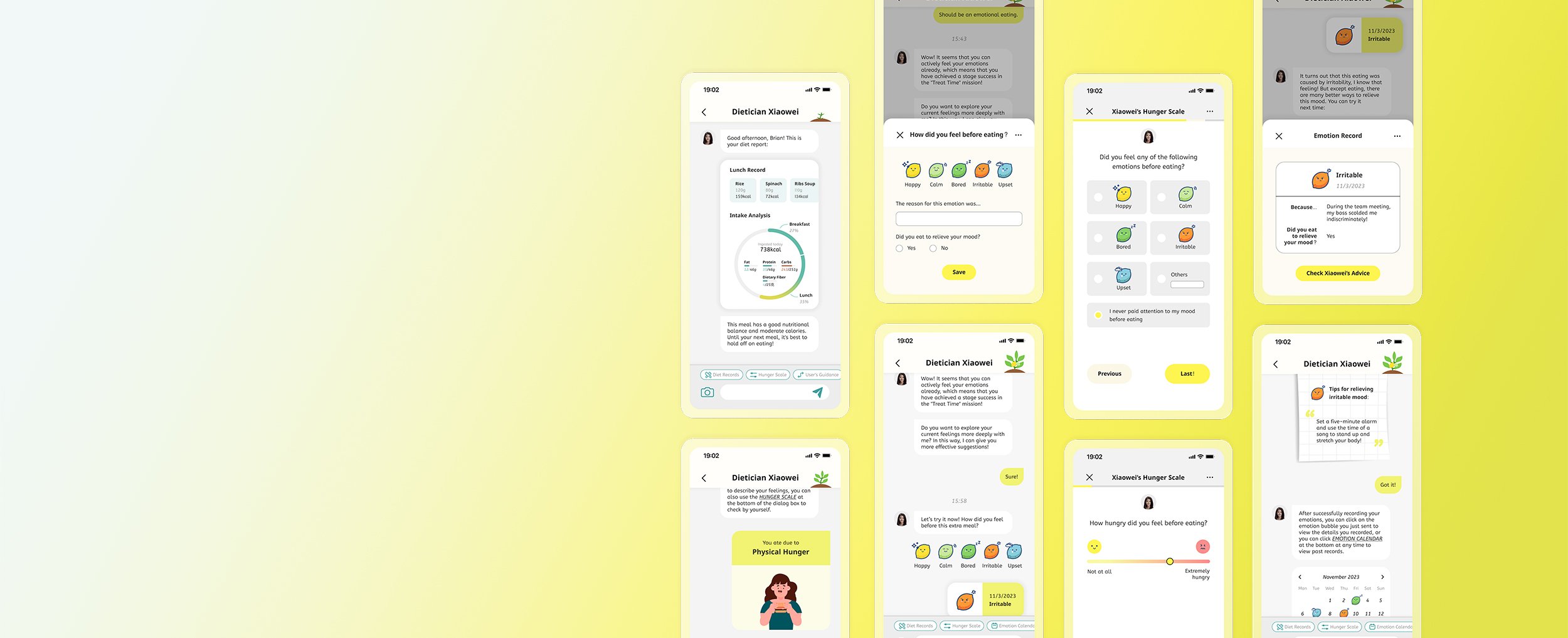
Xiaowei – an AI dietician for health and weight management
Conversational Interaction Design
Project Type
Client Project
My Role
Team Leader
UX Researcher
UX/Conversation Designer
Timeline
Aug - Nov 2023
Team
Linda Xiao
Qingying Yu
Kexin Yang
Vanessa Huang
Tools
Figma, Notion, Illustrator
OVERVIEW
In this project, we collaborated with our client, LemonBox, a start-up offering personal, nutritional, and living-well advice to customers. Their conversational AI dietician, Xiaowei, recently opened the beta to potential users.
To help our client gain market insights into this new product and improve the functionality of Xiaowei, We studied potential users' daily diet, exercise, and other lifestyle habits. Through this study, we uncovered their struggles and underlying needs in weight management, leading us to identify the key focus of our conversational interaction design – "Emotional Eating."
What are the hidden obstacles for users with weight management needs?
How can we reduce the difficulties of reaching their goal?
PROBLEM
People who care about their weight, diet, and overall physical well-being. Especially emphasizing users with weight loss needs and busy daily work schedules.
TARGET USER
Conversational interactions and detailed dialogue content were created to empower users to attain effective weight and health management.
By addressing minor habits, we offered users straightforward, practical, and handy suggestions on the topic of “Emotional Eating,” allowing users to reach their goals with minimal time and energy investment.
Our eventual goal extends beyond enhancing dietary habits and facilitating weight loss. We aim to elevate both physical and mental well-being, contributing to an overall improvement in their quality of life.
OUTCOME
RESEARCH & ANALYSIS
The current Xiaowei: An AI weight manager & dietician that closely emulates human interaction
Through conversation, Xiaowei helps weight loss by "reshaping cognition" and "changing behavioral habits” and finally facilitates longer-lasting effects and lifelong benefits. According to data from our clients, people with stronger health management willingness are more likely to become loyal users than those who only aim at weight loss. The diagram below summarizes the current user flow of Xiaowei:
Feedback from Real Users for Improvement
While getting positive feedback from users for helping them maintain a healthy diet, Xiaowei also received doubts and criticism:
The delayed response. Active users might not receive timely answers. This slow response undermined trust and reduced user interactions.
Low proactivity. In response to a communication error, Xiaowei suggested: "Talk to me more! It will enhance the accuracy of the information I provide." It encouraged users to contribute to ensuring precision in interactions, rather than fixing the problem by herself.
Lack of empathy. Xiaowei aimed to change users' long-standing habits in a short period. However, pursuing such changes without disrupting users' daily lives was costly.
Competitive analysis: Difficulties to persist are a common issue in various weight management products/services
Although AI dieticians are relatively new to the market, a range of weight management products have already been widely used. We collected the drawbacks of different products/services and found a commonly shared one: the difficulties of persistence for users.
Boohee
As a calorie recording app in China, Boohee was perceived as “troublesome, difficult to persist, lack of follow-up service.”
Keep
The app for online exercise tutorials in China was criticized for increasing charging items, which led to decreasing user motivation.
Habit Tracker on Calendars
Lack of feedback resulted in difficulties in continuing to use.
Fitness Coaches
Need to spend extra time and effort to work out in the gym, which was difficult to persist.
Secondary research and user research: Future aspirations for similar products
Through our user research and a literature review, we consolidated future expectations for similar conversational AI dietician products, which are vital references for the improvements of Xiaowei.
Simplify the process and integrate the weight management intervention into daily habits.
Tailored customization to encourage users' body perception.
Enhance professionalism, consolidate information from various sources, and assist users in gaining a more comprehensive understanding.
Provide multiple daily reminders and caring interactions akin to a friend's support.
Enhance empathy and employ text sentiment analysis to better comprehend user emotions.
User research: Frameworks and secrets to weight management
We conducted comprehensive user interviews with eight potential users to understand their daily diet, exercise habits, and daily schedules. Valuable insights were found during the interviews, allowing us to summarize and build easy-to-understand frameworks, in other words, the secrets to weight management!
01 The Motivating Factors behind Actions
*Color stickers below the tree diagram are quotes from interviews.
Long-term/short-term: Are there any foreseeable time nodes?
Continuous: Motivation comes from clear and proactive goals and is therefore carried out as part of a life plan.
Intermittent: Motivation comes from troubles of detailed events in life so that they will be forgotten and ignored.
02 Stay Motivated
Different motivations can be traced and transformed into each other. When short-term goals are achieved and additional value is sensed, short-term goals will be converted into long-term motivation. For example, a participant who had recently given birth to a baby eight months ago maintained her healthy diet beyond pregnancy. Recognizing the advantages of health management during that period, she aimed to transform it into a lifelong habit for health purposes.
However, intermittent motivation tends to be unsustainable in the long run. Therefore, it is vital to help users discover their intrinsic motivations for managing their health. Converting fleeting impulses into long-lasting commitment is the key to ensuring continuous user engagement.
03 Enhance Users’ Persistence in Daily Exercise
Necessity: Inescapable, with potentially severe consequences if neglected, which impacts exercise frequency.
Initiative: Driven by subjective personal will, influencing one's exercise motivation.
When the user's initiative and the necessity of exercise motivation are both strong, their exercise behavior is the easiest to continue. Therefore, we can make exercise more accessible by combining two exercise motivations with high initiative and necessity.
04 Factors Influencing Dietary Choices
Food choices are not always decided by ourselves. Dietary decisions are occasionally beyond one's control.
*Color stickers below the tree diagram are quotes from interviews.
So, what commonalities exist among factors influencing weight and health management? – Inner feelings and emotions.
According to our user research, emotion is a hidden factor commonly shared within different perspectives of weight and health management. Therefore, we chose to focus on the impact of emotions in our further design.
Quotes from Interviews Mentioning “Emotional Eating”
What is “Emotional Eating”?
Emotional eating refers to people turning to food to cope with negative emotions when experiencing mood swings, stress, anxiety, or low mood.
Overeat: The quantity of food/calorie intake surpasses the controlled range.
Consuming food when not feeling hungry: Eating that is not caused by hunger or not for satiety.
Motivations to eat: Emotional eating is mostly eating to relieve negative emotions.
Moods after eating: Most emotional eating involves feelings of guilt.
Key Focuses of Emotional Eating
Vicious Circle Caused by Emotional Eating
DESIGN
Key Features: How might we improve Xiaowei's overall performance?

Pain Point 1:
Unified suggestions cannot meet individual needs and are challenging to implement.
User Features
Each user has unique physical conditions and personal living habits. Recommendations that work for one person may not be suitable for another.
The Current Xiaowei
Xiaowei's messaging is standardized, providing identical suggestions that may not be universally applicable, which can lead to user confusion.
Xiaowei's character design needs to align with the user's psychological state. The knowledge output needs to correspond to the user's cognitive level. The intervention time should be tailored to users’ schedules.
Solution: Personalization

The significance of diet extends beyond calorie intake, which Xiaowei ignored. There is a gap between data recording and user perception.
Pain Point 2:
User Features
Users doubt the data recording’s accuracy, leading to missing records. They prioritize subjective sensations over objective data for successful health management. For example, food holds additional significance beyond calories, serving as self-rewards with high-sugar and high-fat options.
The Current Xiaowei
Xiaowei primarily aims to help users develop a healthy awareness of food through calorie tracking.
Solution: Pay attention to subjective feelings
In addition to calorie tracking, recording and assisting users in understanding their subjective sensations is essential. This way, they can effectively influence their eating habits by improving their emotional well-being.

Users’ demanding work pace makes it challenging to allocate energy for health management, posing difficulties in sustaining it over the long term.
Pain Point 3:
User Features
In addition to professional advice, users often seek experiences from others on social media. Given that objective factors often constrain users' lifestyles, making subtle, progressive changes (habit formation without pain) is necessary to achieve the desired outcomes.
The Current Xiaowei
Xiaowei's knowledge output is mainly theoretical and needs more practical suggestions.
The suggestions put forward by Xiaowei should be tailored to fit users' daily lives and simplified to enhance execution and ease of adherence.
Solution: Executable advice
What is our ideal Xiaowei like?

How might we incorporate the concept of emotional eating into design?
Scenario: How might Xiaowei solve a user’s emotional eating problem in reality?
Jason is an entry-level Software Development Engineer in Shanghai. He joined the company this year. As a newcomer to the company, he struggles to make friends due to his introversion. The high-pressure work environment has led him to develop a habit of using food as a coping mechanism. However, his increasing weight gain is causing him additional anxiety. Recognizing this unhealthy cycle, Jason is eager to make a change.
Final Design
Stages of Conversation
User Flow
Stage 1: Understand the User’s Eating Habits
The key focus of the first stage is to learn about users' personal habits through dietary tracking. This includes regular meal times, snacking habits, and dietary preferences. So, in subsequent stages, Xiaowei can provide personalized suggestions based on users' habits.
Data Visualization
As a reminder of intake control, the progress circle bar will turn from green to yellow and finally to red as a visual cue when users’ calorie and nutrient intake approaches or exceeds the daily recommended limit.
Low Intake
If users’ calorie intake during a meal is below the recommended limit, Xiaowei will offer suggestions for low-calorie snacks to reduce their afternoon hunger.
Normal Intake
When users report a meal intake slightly below the recommended limit, Xiaowei will respond with kind and encouraging feedback.
Stage 2: Identify, Educate, and Intervene Emotional Eating
In the second stage, Xiaowei identifies emotional eating in users’ daily diets and suggests alternative food choices. We designed a tool called “Hunger Scale,” an H5 link embedded in the conversation to define whether the user is experiencing an emotional or physiological hunger.
Define Emotional/Physiological Hunger with the “Hunger Scale”
The H5 questionnaire embedded in the conversational interface asks questions about the causes of eating, the level of hunger, and users’ feelings before and after eating. With the results from the questionnaire, Xiaoewi can provide appropriate advice to users according to their needs.
Physiological Hunger
If the result from the questionnaire is “Physiological Hunger,” Xiaowei will provide food suggestions that are low-calorie but filling, such as Greek yogurt and popcorn.
Emotional Hunger
If the result from the questionnaire is “Emotional Hunger,” Xiaowei will provide suggestions for food that is low in calories but rich in ingredients that can promote the secretion of happy hormones such as dopamine. Examples of this kind of food include dark chocolates and bananas.
Stage 3: Fundamentally Reduce Emotional Eating
In the third stage, Xiaowei guides users in identifying and recording their feelings before emotional eating, where “Mood Calendar” will be introduced. In this way, users can gradually realize their emotions before taking snacks to relieve bad moods and pick up alternative solutions to these negative feelings provided by Xiaowei.
The “Mood Calendar” for Identifying and Recording Feelings Before Eating
The “Mood Calendar” is a pop-up overlay embedded in the conversation interface that invites users to select and record their emotions before emotional eating (but the conversation will usually happen after the eating). Users can directly get Xiaowei's suggestions for alternative solutions after recording.
Guide Users to Mind Their Emotions
Once users can recognize emotional eating patterns, Xiaowei will prompt them to use the “Mood Calendar,” guiding them to identify and record their feelings before snacks.
Review the Emotions
Users can review their records of emotional eating via the “Mood Calendar.” It shows the moods, the causes behind them, and alternative solutions suggested by Xiaowei.
REFLECTIONS & NEXT STEPS
This project meant a lot “first time” to me. It was my very first project to collaborate with a group of UX enthusiasts, an actual client, and it introduced the concept of conversational interaction design to me. I was so grateful to have this valuable opportunity to learn a new field within UX design, even though it looked green with indispensable flaws.
For our current design on the topic of “Emotional Eating,” we still need to conduct more secondary research on this specific theme to understand its causes and impacts, in order to improve the conversational content we have created. More importantly, usability testing is necessary for our current design. It can help us gather user reactions to our dialogue content, real user examples of emotional eating, and user feedback.
In the long run, beyond the “Emotional Eating” topic, more topics within the broad field of weight and health management are awaiting us to explore and incorporate into the design of Xiaowei.




